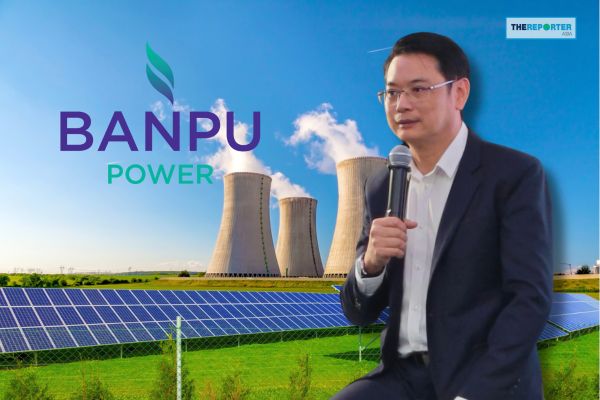Banpu Power (BPP) Closes 2024 Beautifully, Earning 25.8 Billion Baht in Revenue and 1.7 Billion Baht in Net Profit, Announces Full Steam Ahead for Gas-Fired and Renewable Power Plant Investments, Aiming for 65% EBITDA from Clean Energy by 2030
Bangkok, Thailand – Banpu Power Public Company Limited (BPP), a leading international power producer, announced its strong operating results for the year 2024, with total revenue of 25.8 billion baht, earnings before interest, taxes, depreciation, and amortization (EBITDA) of 7.4 billion baht, and a net profit of 1.7 billion baht. This reflects the success of its power plant management and investment strategy focused on sustainable growth.
2024 Performance Highlights
2024 was a year in which BPP achieved impressive results. Key contributing factors were Temple I and II power plants in the United States, which generated significant revenue. Meanwhile, thermal power plants continued to be a major source of revenue and generated strong EBITDA for the company.
Furthermore, BPP was successful in managing risks from market volatility (operational resilience mitigating market impacts). As a result, the company maintained a net profit of 1.7 billion baht and a low net debt-to-equity (Net D/E) ratio of only 0.49, reflecting the company’s financial stability.
Another outstanding achievement in 2024 was the record-high revenue from Carbon Emission Allowances (CEA), or rights to emit greenhouse gases, of 28 million yuan. This was a result of the efficient management of greenhouse gas emissions from power plants in China.
These achievements led to BPP receiving an A+ credit rating from Tris Ratings with a “Stable” outlook, and the AAA level SET ESG Rating 2024, the highest level. This reflects the commitment to sustainable business operations and social responsibility.
Moving Forward with Investments in Gas-Fired and Renewable Power Plants:
During the announcement of these operating results, BPP also announced its strategic plan for 2025-2030. This underscores its vision to be a leader in technology-driven energy and to prioritize sustainable growth (Tech-Powered Energy). BPP plans to continuously invest in natural gas-fired and renewable power plants.
“We will continue to invest in gas-fired power plants, which are considered an important transition fuel,” said Mr. Issara Niropas, Chief Executive Officer of Banpu Power Public Company Limited (BPP). “We aim to increase the generating capacity of gas-fired power plants by another 1,500 megawatts, both in the United States and other regions with potential.”
Alongside investments in gas-fired power plants, BPP also prioritizes expanding its generating capacity in clean energy. There are plans to increase the proportion of renewables (Renewables+) in its portfolio. This includes investments in Battery Energy Storage Systems (BESS), Carbon Capture, Utilization, and Storage (CCUS) technologies, and other digital solutions.
Target of 65% EBITDA from Clean Energy:
BPP has set a challenging and clear goal demonstrating its commitment to transitioning to clean energy. It aims to increase the proportion of earnings before interest, taxes, depreciation, and amortization (EBITDA) from environmentally friendly assets (Greener assets) to more than 65% by 2030 (A.D. 2030). It also aims for a total EBITDA growth of more than 1.8 times by 2030.
Significance of this Goal:
- Reducing Greenhouse Gas Emissions: Increasing the proportion of clean energy in the portfolio will help reduce BPP’s greenhouse gas emissions, in line with global goals to mitigate global warming.
- Business Sustainability: Investing in clean energy is an investment in the future, as the demand for clean energy is expected to increase continuously.
- Image and Credibility: Setting clear clean energy goals will enhance BPP’s image and credibility in the eyes of investors, partners, and other stakeholders.
- Access to Funding: Investors and financial institutions around the world are increasingly prioritizing investments in sustainable businesses. Having clear clean energy goals will help BPP access funding more easily and potentially receive better terms.
Origin of the Goal:
- Company Vision: This goal reflects BPP’s vision to be a leader in sustainable energy.
- Global Trends: This goal is in line with global trends towards clean energy and reducing greenhouse gas emissions.
- Government Policies: Governments in many countries (including Thailand) have policies to promote investment in renewable energy, which supports BPP’s setting of this goal.
Related Strategies:
- Investment in Renewable Energy: BPP plans to continuously invest in various renewable energy projects, such as solar, wind, and BESS.
- Technology Development: BPP prioritizes developing and adopting new technologies, such as CCUS and digital solutions, to increase efficiency and reduce the environmental impact of its power plants.
- Improvement of Existing Power Plants: BPP plans to improve its existing thermal power plants to be more efficient and reduce greenhouse gas emissions.
- Management of Carbon Emission Allowance (CEA): BPP manages quotas and trades CEA.
Greener Assets: In this context, BPP refers to renewable power plants (Renewables+) and may include natural gas-fired power plants with technologies that help reduce greenhouse gas emissions (such as CCUS).
BPP plans capital expenditure (CAPEX) for 2025-2030, allocating 60% for gas-fired power plants and 40% for renewable energy and related technologies.

Diagram of Changing EBITDA Proportions:
Based on the presented information, BPP is clearly shifting the proportion of EBITDA from different energy sources. In 2024, the main proportion still comes from coal-fired power plants (70%), followed by gas-fired power plants (30%). However, by 2030, BPP aims to change this structure so that gas-fired power plants have the largest EBITDA proportion (50%), followed by renewables (20%), and coal-fired power plants will be reduced to only 30%.
Global Opportunities and Challenges:
BPP sees opportunities for growth in global energy markets, driven by several factors, including increasing energy demand, the transition to clean energy, and the development of new technologies. However, the energy market still has challenges that BPP must face and prepare for.
United States:
- Opportunities:
- Data Centers: The rapid growth of data centers in Texas, driven by the expansion of AI technology and Big Data processing, is a key factor driving up electricity demand. BPP, which already has power plants in Texas, is in an advantageous position to seize this opportunity.
- Pro-Production Policies: The US federal government’s policies promoting the reshoring of manufacturing and expanding investment in the industrial sector, particularly in the energy-intensive semiconductor industry, will be another significant driver of electricity demand.
- Renewable Energy: Although the US still relies on natural gas, there is continuous growth in renewable energy, especially wind and solar, where BPP has expertise and plans to expand its investments.
- Challenges:
- Price Volatility: The electricity market in the US (especially in Texas) is a deregulated market with high price volatility. BPP must manage risk carefully.
- Competition: The energy market in the US is highly competitive. BPP faces competition from other players, including independent power producers (IPPs) and utilities.
- Regulations: Changes in environmental and energy regulations may impact the production costs and operations of power plants.
China:
- Opportunities:
- Carbon Emission Allowance (CEA) Trading Market: China has one of the largest carbon trading markets in the world, which provides BPP with the opportunity to generate revenue from selling CEAs obtained through efficient greenhouse gas emission management.
- AI and Technology: The rapid development of AI and Big Data technologies in China may lead to a significant increase in energy demand (Jevons Paradox), which BPP can meet with its existing power plants and new projects.
- Clean Energy: The Chinese government has policies to actively promote investment in clean energy. BPP therefore has the opportunity to expand its renewable energy portfolio in China.
- Challenges:
- Policies: Changes in China’s energy and environmental policies may affect BPP’s business operations.
- Competition: The energy market in China is highly competitive, with many large state-owned enterprises.
- DeepSeek & Jevons Paradox
Thailand:
- Opportunities:
- Electricity Demand Demand for electricity in Thailand continues
- Power Plant Efficiency: BPP’s HPC and BLCP power plants are highly efficient (High EAF) and have low production costs, giving BPP a competitive advantage.
- Challenges:
- Electricity Tariff Reduction: Although BPP confirms that it will not be affected by the electricity tariff reduction, changes in the government’s energy policy remain a factor to be closely monitored.
- Competition: The electricity market in Thailand is becoming more competitive, with new power producers entering the market. Risk Management Strategy:
BPP prioritizes comprehensive risk management, especially in the energy business, which is subject to fluctuations in fuel prices and exchange rates, as well as uncertainties in policies and regulations. The company has actively implemented hedging strategies to mitigate the impact of uncontrollable external factors and ensure stable cash flow.
Mr. Issara Niropas, CEO of BPP, emphasized the importance of the hedging strategy: “We use hedging strategies to reduce the risk from energy price volatility and create stability for our cash flow, which will help the company operate steadily and be able to invest in future projects.”
Especially for Temple I and II power plants in the United States, which are in a merchant market where electricity prices fluctuate according to supply and demand at any given time, BPP has entered into hedging contracts to lock in future electricity selling prices at a certain level. This helps reduce the risk from price volatility and provides the company with more predictable revenue.
From the information presented by BPP, it can be seen that the company has hedged 700 MW for Temple I and II power plants in 2024 and 2025 and plans to hedge further for 2026, aiming to hedge approximately 50% of production capacity, in accordance with the company’s policy.
Hedging not only helps reduce the risk from electricity price fluctuations, but also enables BPP to manage its financial costs efficiently. This is because the stable cash flow from hedging helps the company cover fixed costs and financial expenses.
In addition to hedging strategies, BPP also manages risks in other areas, such as:
- Geographic Diversification: BPP invests in multiple countries, reducing the risk of over-reliance on any single market.
- Fuel Diversification: BPP has power plants that use various types of fuel, including coal, natural gas, and renewable energy, reducing the risk from price fluctuations of any single fuel type.
- Power Purchase Agreement (PPA) Management: BPP has clear and secure Power Purchase Agreements (PPAs), which help reduce revenue risk.
- Risk Monitoring and Assessment: BPP has a process for regularly monitoring and assessing risks in order to adapt its strategies to changing situations.
From good operating results, BPP has announced a total dividend payment of 0.60 baht per share, of which 0.30 baht has already been paid, and an additional 0.30 baht will be paid in late April.
BPP demonstrates strength in both operating and financial performance, while setting a clear strategy to become a leader in sustainable energy at the international level. This is achieved by investing in clean energy technologies alongside effectively managing existing thermal power plants.
#BPP #BanpuPower #Performance #Energy #PowerPlant #RenewableEnergy #EnergyTechnology #Stock #Investment #ESG #DataCenter #CCUS #BESS






